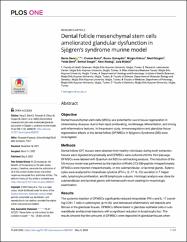| dc.contributor.author | Genç, Deniz | |
| dc.contributor.author | Bulut, Osman | |
| dc.contributor.author | Günaydın, Burcu | |
| dc.contributor.author | Göksu, Mizgin | |
| dc.contributor.author | Düzgün, Mert | |
| dc.contributor.author | Dere, Yelda | |
| dc.contributor.author | Sezgin, Serhat | |
| dc.contributor.author | Aladağ, Akın | |
| dc.contributor.author | Bülbül, Aziz | |
| dc.date.accessioned | 2022-05-10T13:30:34Z | |
| dc.date.available | 2022-05-10T13:30:34Z | |
| dc.date.issued | 2022 | en_US |
| dc.identifier.citation | 1. Genç D, Bulut O, Günaydin B, Göksu M, Düzgün M, Dere Y, et al.. Dental follicle mesenchymal stem cells ameliorated glandular dysfunction in Sjögren’s syndrome murine model. PLOS ONE. PLOS ONE; 2022;17: e0266137. doi:10.1371/journal.pone.0266137 | en_US |
| dc.identifier.uri | https://doi.org/ 10.1371/journal.pone.0266137 | |
| dc.identifier.uri | https://hdl.handle.net/20.500.12809/9961 | |
| dc.description.abstract | Objective: Dental mesenchymal stem cells (MSCs) are potential for use in tissue regeneration in inflammatory diseases due to their rapid proliferating, multilineage differentiation, and strong anti-inflammatory features. In the present study, immunoregulatory and glandular tissue regeneration effects of the dental follicle (DF)MSCs in Sjögren's Syndrome (SS) were investigated.
Methods: Dental follicle (DF) tissues were obtained from healthy individuals during tooth extraction, tissues were digested enzymatically and DFMSCs were cultured until the third passage. DFMSCs were labeled with Quantum dot 655 for cell tracking analysis. The induction of the SS mouse model was performed by the injection of Ro60-273-289 peptide intraperitoneally. DFMSCs were injected intraperitoneally, or into submandibular, or lacrimal glands. Splenocytes were analyzed for intracellular cytokine (IFN-γ, IL-17, IL-10) secretion in T helper cells, lymphocyte proliferation, and B lymphocyte subsets. Histologic analysis was done for submandibular and lacrimal glands with hematoxylin-eosin staining for morphologic examination.
Results: The systemic injection of DFMSCs significantly reduced intracellular IFN-γ and IL-17 secreting CD4+ T cells in splenocytes (p<0.05), and decreased inflammatory cell deposits and fibrosis in the glandular tissues. DFMSCs differentiated to glandular epithelial cells in submandibular and lacrimal injections with a significant reduction in lymphocytic foci. The results showed that few amounts of DFMSCs were deposited in glandular tissues when applied intraperitoneally, while high amounts of DFMSCs were located in glandular tissues and differentiated to glandular epithelial cells when applied locally in SS murine model.
Conclusion: DFMSCs have the potential for the regulation of Th1, Th17, and Treg balance in SS, and ameliorate glandular dysfunction. DFMSCs can be a beneficial therapeutic application for SS. | en_US |
| dc.item-language.iso | eng | en_US |
| dc.publisher | Plos | en_US |
| dc.relation.isversionof | 10.1371/journal.pone.0266137 | en_US |
| dc.item-rights | info:eu-repo/semantics/openAccess | en_US |
| dc.subject | Dental mesenchymal | en_US |
| dc.title | Dental follicle mesenchymal stem cells ameliorated glandular dysfunction in Sjögren's syndrome murine model | en_US |
| dc.item-type | article | en_US |
| dc.contributor.department | MÜ, Sağlık Bilimleri Fakültesi, Hemşirelik Bölümü | en_US |
| dc.contributor.authorID | 0000-0003-0351-2805 | en_US |
| dc.contributor.institutionauthor | Genç, Deniz | |
| dc.contributor.institutionauthor | Bulut, Osman | |
| dc.contributor.institutionauthor | Günaydın, Burcu | |
| dc.contributor.institutionauthor | Göksu, Mizgin | |
| dc.contributor.institutionauthor | Düzgün, Mert | |
| dc.contributor.institutionauthor | Dere, Yelda | |
| dc.contributor.institutionauthor | Sezgin, Serhat | |
| dc.contributor.institutionauthor | Aladağ, Akın | |
| dc.contributor.institutionauthor | Bülbül, Aziz | |
| dc.identifier.volume | 17 | en_US |
| dc.identifier.issue | 5 | en_US |
| dc.relation.journal | Plos One | en_US |
| dc.relation.publicationcategory | Makale - Uluslararası Hakemli Dergi - Kurum Öğretim Elemanı | en_US |


















